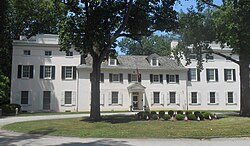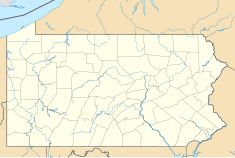
Fairmount Park is the largest municipal park in Philadelphia and the historic name for a group of parks located throughout the city. Fairmount Park consists of two park sections named East Park and West Park, divided by the Schuylkill River, with the two sections together totalling 2,052 acres (830 ha). Management of Fairmount Park and the entire citywide park system is overseen by Philadelphia Parks & Recreation, a city department created in 2010 from the merger of the Fairmount Park Commission and the Department of Recreation.
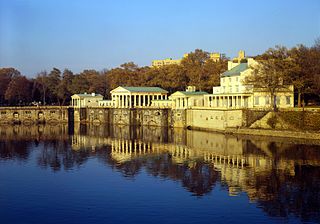
The Fairmount Water Works in Philadelphia, Pennsylvania, was Philadelphia's second municipal waterworks. Designed in 1812 by Frederick Graff and built between 1812 and 1872, it operated until 1909, winning praise for its design and becoming a popular tourist attraction. It now houses a restaurant and an interpretive center that explains the waterworks' purpose and local watershed history. It was designated a National Historic Landmark in 1976 for its architecture and its engineering innovations. It was the nation's first water supply to use paddle wheels to move water.

Joseph Hemphill was an American politician who served as a Federalist member of the U.S. House of Representatives for Pennsylvania's 3rd congressional district from 1801 to 1803, as a Jackson Federalist representative for Pennsylvania's 1st congressional district from 1819 to 1823 and as a Jacksonian representative for Pennsylvania's 2nd congressional district from 1829 to 1831.

The Cliffs is a historic country house located near 33rd and Oxford Streets in East Fairmount Park, Philadelphia. It is a Registered Historic Place.

Belmont Mansion is a historic mansion located in Fairmount Park in Philadelphia. Built in the early 18th century, the mansion is one of the finest examples of Palladian architecture in the United States. Since 2007, the mansion has hosted the Underground Railroad Museum.
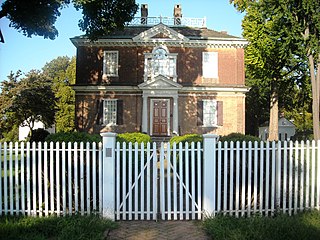
Woodford is a historic mansion at Ford Road and Greenland Drive in Fairmount Park, Philadelphia, Pennsylvania. Built c. 1756, it is the first of Philadelphia's great colonial Georgian mansion houses to be built, and exemplifies the opulence of such houses. A National Historic Landmark, it now a historic house museum open to the public.

Mount Pleasant is a historic mansion in Philadelphia, Pennsylvania, atop cliffs overlooking the Schuylkill River. It was built about 1761–62 in what was then the countryside outside the city by John Macpherson and his wife Margaret. Macpherson was a privateer, or perhaps a pirate, who had had "an arm twice shot off" according to John Adams. He named the house "Clunie" after the ancient seat of his family's clan in Scotland.

The Strawberry Mansion Bridge is a steel arch truss bridge across the Schuylkill River in Fairmount Park in Philadelphia, Pennsylvania.

Sweetbriar is a Neoclassical mansion in the Federal style built in 1797 in West Fairmount Park, Philadelphia. The mansion was built by Samuel Breck and named for the roses that grew on the property. The interior includes a double parlor and floor-to-ceiling windows with sweeping views of the Schuylkill River. Period pieces include Chinese armorial porcelain, Hepplewhite and Sheraton style chairs, and Adam style furniture. Wedgwood jasperware and fireplaces with delicate plaster decorations were influenced by discoveries in the ancient houses of Pompeii. Bird prints by John James Audubon and paintings by William Birch decorate the walls.

Lemon Hill is a Federal-style mansion in Fairmount Park, Philadelphia, built from 1799 to 1800 by Philadelphia merchant Henry Pratt. The house is named after the citrus fruits that Pratt cultivated on the property in the early 19th century.

William Lewis was a United States Attorney for the District of Pennsylvania and a United States district judge of the United States District Court for the District of Pennsylvania.
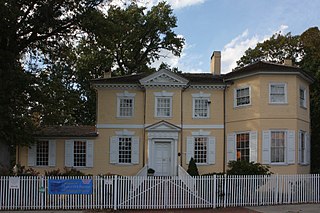
Randolph House, also known as Laurel Hill Mansion, is a historic mansion in east Fairmount Park, Philadelphia, Pennsylvania.

Chamounix is a historic home located in Fairmount Park, Philadelphia, Pennsylvania. The Federal-style house was built in 1802 by George Plumsted who was a wealthy Philadelphia merchant, then enlarged to nearly double its original size by subsequent owners after 1853. Chamounix is a 2½-story stuccoed stone dwelling measuring 45 feet (14 m) long and 47 feet (14 m) deep, featuring a hipped roof with dormers and a porch on three sides with decorative iron supports. The house served as a country retreat until it was appropriated by the state via eminent domain in 1869 to become a part of Fairmount Park, from which time it was used in various ways including as a boarding house, a restaurant, and a refreshment stand. After years of neglect and then fire damage, the Fairmount Park Commission decided to demolish Chamounix; however, a committee of the former American Youth Hostels successfully petitioned to save it and, since 1964, it has served as an international youth hostel.

Boelson Cottage is a Dutch and Swedish-style colonial era cottage located in Fairmount Park, Philadelphia. The 1+1⁄2-story gambrel-roofed fieldstone cottage was built sometime between 1678 and 1684. The cottage is situated on the west bank of the Schuylkill River within a plot of 100 acres (40 ha) of land granted to John Boelson in 1677 by the Swedish colonial court in Upland, Pennsylvania. Boelson's cottage is the oldest extant structure in Fairmount Park.

Cedar Grove Mansion, located in west Fairmount Park, was the summer residence for five generations of Philadelphia families. The house was built as a rural retreat from city life, and was originally located within the present day Frankford neighborhood of Northeast Philadelphia, about 4 mi (6.4 km) beyond the colonial-era city limits. In 1746, Elizabeth Coates Paschall purchased the property on which the house was subsequently built. Paschall was a widow with three children who had inherited her husband's dry goods business and desired a rural retreat from the city near her father's farm in Frankford. Construction of the grey stone house on a plot of 15 acres (6.1 ha) along Frankford Road began in 1748 and continued to 1750.

Ormiston Mansion is a 2+1⁄2-story, red brick, late Georgian period house located in east Fairmount Park, Philadelphia. The house was constructed in 1798 with a large wooden porch in front and a smaller porch in the rear. Many of the original interior features remain including fireplaces with marble mantles and a Scottish bake oven. The cedar shake roof includes a widow's walk and Federal-style dormers, while six large shuttered windows are on each side of the house, and five on the front. The first floor interior includes a large drawing room spanning the entire width of the house, a kitchen, and a dining room with a large door leading to the rear porch. The back of the house overlooks the Schuylkill River.

Ridgeland Mansion is an historic two-and-a-half story, gable-roofed house located in west Fairmount Park, Philadelphia. The land was purchased by a yeoman named William Couch in 1718 and the current house was probably constructed sometime between 1752 and 1762.

The Rockland Mansion is a 2+1⁄2-story, Federal-style mansion that is located in east Fairmount Park, Philadelphia, overlooking the Schuylkill River.

The Solitude Mansion is an historic, American, two-and-a-half story Federal-style mansion at is located in west Fairmount Park, Philadelphia, Pennsylvania. It is situated above the banks of the Schuylkill River on the grounds of the Philadelphia Zoo.
